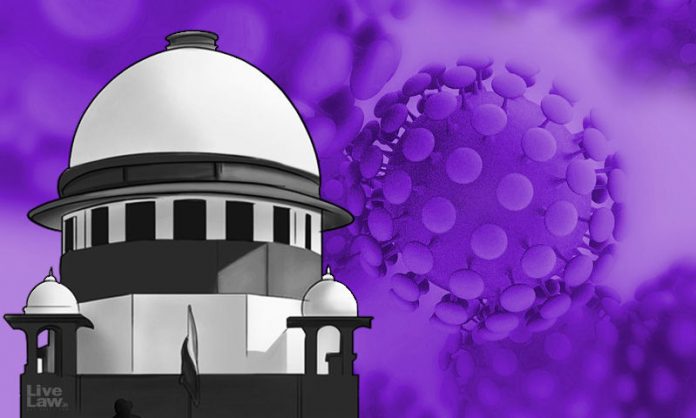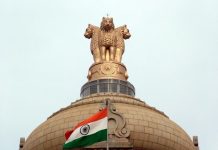This article is written by Ms. Reet Balmiki from NALSAR University of Law. This is an exhaustive article which deals with the efforts of the judiciary and the executive to ensure oxygen supply amidst the pandemic.
Table of Contents
Introduction
It is believed that in order for a democracy to promote liberty effectively, the branches of the government must be separate and act independently. Although the Constitution of India lays down the well-defined functions of these branches to limit any branch from exercising the core functions of another, it does not advocate a rigid separation of powers. This has been done to ensure effective checks and balances of power between the branches.
While the doctrine of separation of power lies in the heart of every democracy, this must not be understood as advocating an absolute separation of power where each branch works in isolation. The separation of power is not absolute in order to prevent the concentration of power within one branch and provide for possible checks and balances between the branches. Such a system involving checks and balances requires a degree of mutual supervision between the branches which cannot be done without some level of interference by one branch into the functions of the other.
Though it is a primary function of the executive to look over society’s day-to-day affairs, it is well within the role of the judiciary to ensure that the executive’s actions while managing such affairs are consistent with the constitution. Thus, even though the two branches act independently, the judiciary has the power of judicial review over the actions of the executive.
The oxygen supply crisis in India at present
Understanding the situation
India has been hit by a huge second wave of coronavirus which has shaken the country and its capacity to combat the virus. The country which is now facing a severe shortage of oxygen supplies was till recently exporting oxygen to other nations. In fact, the country sold twice as much oxygen during the first 10 months of this financial year, as compared to the entire financial year before it. Despite such a huge supply, such a scramble in the country indicates a lack of planning and unpreparedness on the part of the government to manage the second wave of the virus.
Around 10-15% of the covid patients are affected by hypoxaemia and require oxygen therapy. Though this percentage seems small, the variant of the virus during the second wave spread faster thus infecting a large number of people at once and causing a sudden hike in the demand for oxygen supplies in the country. However, such a hike was not unpredictable and several experts had warned the people against it.
The fact that the country can produce over 7000 tonnes a day and is yet facing a shortage indicates that the cause for such an immense shortage lies elsewhere.
Causes
Mismanagement on the government’s part
Despite several experts warning against the threats of the second wave, the government failed to make arrangements to mitigate its impact. Even though the country is producing enough oxygen to provide to the patients, due to uneven supply and lack of proper logistics the supplies are not provided where there is a demand.
While most oxygen producers are based in the eastern part of the country, there was a huge demand in the western and northern parts. Due to the lack of proper facilities to transport the oxygen cylinders, it became difficult to provide these supplies where there is a demand. This led to a lack of action from the authorities during the beginning of the second surge, which caused an escalation of the demand.
Black marketing
As many hospitals started asking family members to procure the drugs and supplies needed for the patients, the family members had no choice but to resort to the black market due to the shortage. The prices for oxygen supplies and drugs skyrocketed making it difficult to procure them during the hour of need. This resulted due to a lack of proper checks on the production and sale of these supplies. The government’s inability to regulate the market for such necessities in the time of need left millions of poor in the country stranded to their fate.
Management in hospitals
Many hospitals that were supposed to indicate a need for supplies at least 12 hours before, often failed to do so and would notify the authorities merely a couple of hours before. This made it difficult to ensure constant supply in the hospitals and avoid deaths due to a shortage of oxygen supplies.
In a tragic incident that occurred in Nashik, at least 24 patients lost their lives not due to a shortage of supplies but due to a leak in the medical oxygen tank. Over 157 patients have been reported to have needed oxygen supplies in the hospital at that time. Such an incident did not just cause the death of 24 patients while endangering others’ lives but also led to the wastage of the precious resource.
The executive’s role to eliminate the crisis for the people of the country
The government has taken several steps to regain control over the situation and prevent the situation from getting worse. As per the statement made by Mr. Arwind Kejriwal, these efforts have enabled the government to bring the situation back under control and begin to take precautions against the predicted third wave.
Ban on supply of oxygen for industrial use
The sudden spike in the cases and thus the demand for oxygen supplies required that the maximum amount produced by the country be devoted to the urgent situation at hand. This led the country to increase the production from 7,200 tonnes a day to 9,200 tonnes a day.
While earlier only 15% of the entire capacity produced was dedicated to medical purposes, the sudden rise in demand has caused the centre to order a ban on industrial use of oxygen on 22 April 2021 thus, dedicating the entire capacity for medical use to ensure proper supply.
No restriction on movement of oxygen supplies
In order to overcome the challenges posed by the huge distance between the production site of the supplies and the areas of high demand, the government on 22nd April 2021 removed all inter-state and intra-state restrictions on the movement of oxygen supplies. This was done to ensure a smooth and uninterrupted supply of medical oxygen across the country and avoid any delay that could be caused due to such restrictions.
This order was issued under the Disaster Management Act, 2005 and any violation will be punished as per Section 51-60 of the Act. The penalties laid down under these sections range from a simple fine to 1-2 years of imprisonment, based on the nature of the violation.
Oxygen express trains
In addition to removing restrictions on road transport of oxygen supplies, the Indian railways have started the oxygen express trains for easier and faster transportation of oxygen cylinders over a long distance. The Indian railways have done meticulous planning in order to ensure these reach the destination in time.
These trains have delivered over 2,067 tonnes of medical oxygens in 16 days, a large number being in the northern part of the country. They have assisted in overcoming the problem of delayed delivery due to long distances.
Foreign aid
The country is receiving international support and cooperation for COVID-19 medical supplies from different countries and organisations around the world. It received 11,321 oxygen concentrators and 15,801 oxygen cylinders between April 27 to May 16 alone.
Major contributions have been made by several countries such as the US, the UK, France, Russia, Germany, and many more, to enable the country to better manage the crisis and fight the virus. The UK alone shipped 600 pieces of medical equipment including 495 oxygen concentrators. Singapore donated 4 oxygen tanks and Saudi Arabia shipped over 80 metric tonnes of liquid oxygen to India. All of these contributions put together have made a huge impact and saved many lives of the people of the country.
The judiciary and its role in the current crisis
Though it is the primary function of the executive to manage the daily societal affairs, in certain cases there is a need for the courts to interfere in order to keep a check on the actions taken by the executive in order to manage certain situations. As the second wave of COVID-19 caused havoc in the country, there was a severe shortage of oxygen supplies and inaction on the government’s part. Over 300 deaths have been recorded where the doctors have confirmed the shortage of oxygen to be a proximate cause for death.
During such a crisis, where not just patients’ families but also several hospitals have been facing difficulty in finding supplies, the courts have intervened and directed the government to provide the supplies needed to reduce the number of deaths. They have also asked the governments to take certain measures to prepare for emergencies and avoid the risk of a crisis-like situation again.
Delhi HC and its observations regarding oxygen supply to COVID patients
After 8 patients died in the national capital Delhi, the High Court asked the city government to consider seeking the assistance of the armed forces to provide for the allocated 490 metric tonnes of oxygen supplies. The Court also criticized the centre for its failure to supply the allocated amount of medical oxygen to the city.
The High Court later issued a show-cause notice to the centre to show the cause as to why contempt action must not be taken for non-compliance with the order issued on May 1st and the Supreme Court’s order directing it to supply 700 metric tonnes to Delhi. The Court went forward to criticise the centre’s lack of action while saying “you can put your head in the sand like an ostrich, we will not”.
It also said that it was painful to see the centre’s attitude towards the supply of oxygen and insisted on the compliance of the previous order issued. It stressed the urgency of the situation and threatened to issue an order of non-compliance against the centre if immediate steps are not taken.
The SC’s direction to the centre on buffer stock of oxygen supply
The Hon’ble Supreme Court taking note of the unprecedented humanitarian crisis in the country took suo moto action on 30th April, 2021. The court assumed jurisdiction under Article 32 of the Constitution of India to seek justification from the centre and the state governments regarding the rationale behind their policies which are bound by the human rights specified under the right to life and right to equality under Article 14 and Article 21 of the Constitution of India. The Court intervened to remedy the heart-rendering situation in the national capital Delhi and held that the protection of the lives of the citizens holds paramount importance during such an emergency.
The Court directed the government to, within two days, rectify the deficit of oxygen supplies and ensure supply on a day to day basis depending upon the demand. The Court further instructed the central and state government to create a buffer emergency stock within four days, which can be used in case the supply chain is disrupted in any region. The location of the emergency stock must be decentralised to ensure that the stocks are easily accessible in case of emergencies in order to maintain the normal chain of supply and avoid loss of life. The Court also suggested the government take certain steps to assist the increase in the availability of oxygen and ensure transparency of the management of these resources.
In order to ensure that the allotment of medical oxygen is made equitably and rationally, the Court on 6th May, 2021 formed a 12 member task force of renowned national experts. The task force was constituted after assent from the government in order to establish a transparent and effective mechanism to allocate the oxygen supplies.
The Courts have played a significant role in ensuring proper action by the executive and maintaining transparency and equity in the actions of the government to ensure that the trust of the citizens is maintained. The Courts merely played a supervisory role by directing the executive to perform their functions in a correct and timely manner and added on a few suggestions and measures to ensure better management by the executive.
Conclusion
The oxygen crisis in India is a perfect example of why the branches of the government must not work in isolation and why there is a need for some level of interference and cooperation. Due to several reasons including the inability to effectively manage the situation by the executive, the second wave had a severe impact on the population of India leaving many all over the country stranded.
The judiciary’s much-needed interference during the humanitarian crisis questioned the government’s inaction. This led to several measures being taken by the government to ensure the demand for oxygen supplies is fulfilled. The courts, however, continued to keep a check on the activities of the government and suggested measures to ensure transparency. These actions of the executive and judiciary together have enabled the country to bring the situation back under control and maintain a proper supply of medical oxygen in the country.
References
- https://www.latestlaws.com/articles/judiciary-executive-legislature-analysis-of-separation-and-overlapping-of-powers/
- https://www.law.ox.ac.uk/sites/files/oxlaw/ak_separation_of_powers_philfounds_book.pdf
- https://www.theweek.in/theweek/current/2021/04/29/what-caused-india-oxygen-crisis-amid-covid-19-pandemic.html
- https://citizenmatters.in/understanding-indias-oxygen-crisis-covid-second-wave-crisis-24854
- https://www.indiatoday.in/india-today-insight/story/india-s-oxygen-crisis-what-needs-to-be-done-1800584-2021-05-09
- https://www.livemint.com/news/india/how-indian-railways-plans-to-use-oxygen-express-train-to-fight-covid-11619254893611.html
- https://www.dw.com/en/india-covid-crisis-aid-arrives-amid-record-case-surge/a-57385161
- https://www.dw.com/en/india-covid-oxygen-shortage/a-57425951
LawSikho has created a telegram group for exchanging legal knowledge, referrals, and various opportunities. You can click on this link and join:













